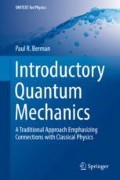Abstract
I have completed most of the material typically covered in a one-semester course on quantum mechanics. There is one additional topic, however, that needs to be discussed, that of intrinsic angular momentum or spin. Spin arises naturally when one considers the relativistic version of the Schrödinger equation, namely the Dirac equation. In that equation the wave function for a free electron has four components, two of which correspond to positive energy solutions. The two positive energy solutions can be associated with two spin components of the electron (the negative energy solutions correspond to anti-particles). Historically, spin was deduced from atomic spectra. In turned out that the spectra could be explained if one assigned an intrinsic angular momentum to the electron. Today we know that all elementary particles possess such an intrinsic angular momentum (which can be zero for some particles). Fermions (named after Enrico Fermi) are particles whose intrinsic angular momentum quantum number corresponds to half integral values of intrinsic spin (measured in units of ħ) while bosons (named after Satyendra Nath Bose) are particles whose intrinsic angular momentum quantum number corresponds to integral values of intrinsic spin.
Notes
- 1.
See, for example, George E. Uhlenbeck and Samuel A. Goudsmit, Spinning Electrons and the Structure of Spectra, Nature 117, 264–265 (1926). For an interesting paper on this discovery, see the article by Abraham Pais, George Uhlenbeck and the discovery of electron spin, Physics Today 42, 34–40 (1989).
- 2.
Walter Gerlach and Otto Stern, Der experimentelle Nachweis der Richtungsquantelung im Magnetfeld (Experimental Proof of Space Quantization in a Magnetic Field), Zeitschrift für Physik. 9, 349–352 (1922); an English translation can be found at
Fig. 12.1 Schematic representation of the Stern-Gerlach experiment. A beam of atoms having randomly oriented magnetic moments are passed through a region where there is a magnetic field gradient. Classically, there is a continuous range of deflection angles. For atoms having quantized angular momentum characterized by the quantum number ℓ, one would expect \( \left ( 2\ell +1 \right ) \) distinct traces
- 3.
It is discussed in Sect. 11.8 in Jackson Classical Electrodynamics, but the derivation is too involved to reproduce here.
- 4.
But see this link, http://aether.lbl.gov/www/classes/p139/homework/seven.pdf.
Author information
Authors and Affiliations
Rights and permissions
Copyright information
© 2018 Springer International Publishing AG
About this chapter
Cite this chapter
Berman, P.R. (2018). Spin. In: Introductory Quantum Mechanics. UNITEXT for Physics. Springer, Cham. https://doi.org/10.1007/978-3-319-68598-4_12
Download citation
DOI: https://doi.org/10.1007/978-3-319-68598-4_12
Published:
Publisher Name: Springer, Cham
Print ISBN: 978-3-319-68596-0
Online ISBN: 978-3-319-68598-4
eBook Packages: Physics and AstronomyPhysics and Astronomy (R0)


